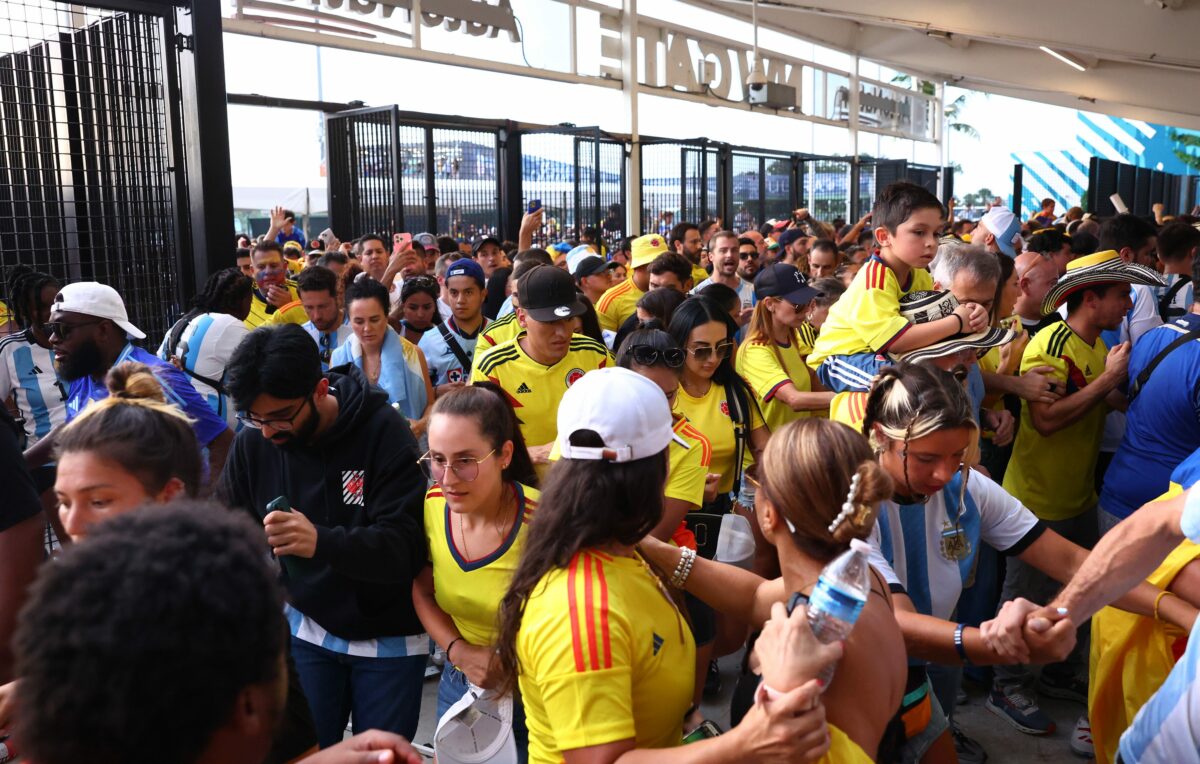When it comes to the 2024 Copa América, tournament organizer CONMEBOL failed to clear the very lowest bar possible.
Before it can promise anything to players, fans, media and officials, an entity putting on a tournament needs to ensure all stakeholders that they will be safe. At this special edition of the Copa América in the United States, that very obviously was not the case.
It started from the first match of the tournament between Argentina and Canada, played on a recently installed grass pitch at Mercedes-Benz Stadium in Atlanta. Very quickly, it became apparent that the pitch was not fit for purpose. At best, it prevented the kind of free-flowing soccer fans and players want to experience. At worst, it was downright dangerous.
“They knew seven months ago that we’d play here and they changed the field two days ago,” Argentina coach Lionel Scaloni said at a post-game press conference. “It’s not an excuse, but this isn’t a good field. Sincerely, the field is not apt for these kinds of players.”
Unfortunately, the kind of pitch in Atlanta — a hastily installed grass field laid over artificial turf — was widespread across the entire tournament.
It didn’t take long for players to start to go down. The Copa was bookended by two very similar injuries to star players.
In Mexico’s opener, captain Edson Álvarez fell to the turf without any contact while sprinting back on defense. He missed the rest of the tournament.
In the final, Argentina star Lionel Messi was injured in almost identical fashion. His night ended in the second half on a non-contact injury, which may have been exacerbated by an ankle injury he suffered in the first half while planting his foot in the turf.
Those two injuries weren’t the only ones, of course, Peru manager Jorge Fossati also blamed AT&T Stadium’s field as a potential reason for the Achilles injury that ended Luis Advíncula’s tournament.
“It came out of nowhere,” Fossati said. “I realize that this is a grass field today but it’s not normal grass. It’s not grass that’s born, and grows [naturally]. It’s a grass they bring in from elsewhere.
“That can be a bit of a harder surface and it can affect you in that exact place [the Achilles]. I’m not a doctor but I’ve been around football for a few years.”

On the field, players were at risk. The situation off the field was even worse for fans.
CONMEBOL was already under fire long before the tournament’s closing stages, but the scenes at one of the semifinals and the final will be the indelible images of this shambolic event.
It’s difficult to imagine a scenario where players enter the stands and literally fight with fans at a major tournament, and even tougher to envision one where those players emerge as sympathetic figures. But that is exactly how the aftermath of the semifinal between Uruguay and Colombia played out.
Uruguayan players stormed into the stands at Bank of America Stadium, with Darwin Núñez in the middle of a brawl with Colombia fans.
As Uruguay defender José María Giménez explained after the game, Núñez was among several players who felt the need to protect their families in the absence of any kind of security.
“This is a disaster,” Giménez said. “Our families are in danger, we had to go into the stands to get our loved ones out with small babies, newborns … a disaster, there was not a single police officer, they came after half an hour, a disaster and we were standing up for our loved ones.”
Darwin consoling one of his children after HE himself had to go fight Colombian fans because there was no security and bring his family to the field.#Uruguay #Colombia #CopaAmerica pic.twitter.com/lSAtaq9IbQ
— Favian Renkel (@FavianRenkel) July 11, 2024
Then, of course, there was the coup de grâce on Sunday at Hard Rock Stadium in Miami.
Fans breached the stadium gates, causing mass chaos ahead of the final. The response from authorities was to close down all entrances, creating a dangerous crush of fans in hot and humid conditions.
The response to that potentially dangerous crush was to let all fans in — ticketless or not. That meant fans who didn’t go through stadium metal detectors were mixed in among those who did.
That is, to say the least, a situation that could have turned into a true disaster.

“It was inhumane,” Silvina, the mother of Argentina midfielder Alexis Mac Allister, told TyC Sports. Mac Allister, while preparing for a final, had to leave the locker room to ensure his family’s safety.
Officials did their best to blame ticketless fans, who surely have to shoulder some of the responsibility. But those officials will also have to reckon with their own decision to not enforce a wider and multi-layered perimeter around the stadium.
Hard Rock Stadium has hosted Super Bowls, major concerts, college football playoff games, NFL games and plenty of other huge events. The chaotic scenes on Sunday didn’t appear at any of those events, though ticketless fans obviously did.
Nobody — not players, fans, referees or media — could have their safety guaranteed at this Copa América. That, much more than Argentina’s historic triumph, will be the enduring takeaway.
For the United States, Mexico, Canada and FIFA, it will also be an urgent imperative to get the World Cup right in two years. If nothing else, they all now have a blueprint of exactly what not to do.
[lawrence-related id=78108,78095,78060]
